Overview
The utilization of a 0.45 micron filter in pharmaceutical laboratories offers significant advantages, including:
- Enhanced sample purity
- Improved flow rates
- Cost-effectiveness
These filters are essential for maintaining quality and compliance in laboratory processes. Notably, they effectively remove contaminants, facilitating faster filtration in high-throughput environments. Furthermore, they are generally more affordable than filters with smaller pore sizes, thus supporting laboratories in achieving reliable and efficient scientific outcomes.
In summary, the integration of 0.45 micron filters not only elevates laboratory standards but also promotes operational efficiency, making them an indispensable asset in the field.
Introduction
In the realm of laboratory research and pharmaceutical development, the purity of samples is of utmost importance. The 0.45 micron filter emerges as an essential tool, meticulously designed to eradicate contaminants while preserving the integrity of the substances under examination.
These filters are not only crucial for sterile filtration but also significantly enhance the efficiency of various analytical processes, ranging from drug formulation to environmental testing. Their unique ability to balance filtration speed with effectiveness has made 0.45 micron filters a favored choice among laboratories dedicated to achieving accuracy and adhering to stringent regulatory standards.
This article explores the significance, applications, and operational principles of these vital filtration devices, shedding light on their critical role in upholding the highest quality standards in scientific research.
JM Science: High-Quality 0.45 Micron Filters for Laboratory Use
JM Science Inc. offers a diverse range of high-quality membranes, including 0.45 micron filters, specifically designed for laboratory applications that are vital for ensuring sample purity in pharmaceutical testing. These membranes are extensively employed in conjunction with advanced titration techniques, including the AQ-300 Coulometric and AQV-300 Volumetric Karl Fischer titrators, both of which are indispensable for pharmaceutical and medicinal testing in compliance with the Japanese Pharmacopoeia.
Manufactured to adhere to stringent quality standards, JM Science's devices utilize a 0.45 micron filter to effectively eliminate contaminants while maintaining impressive flow rates. Their collaboration with leading brands guarantees that their products are not only dependable but also effective, solidifying their reputation as a preferred choice for laboratories striving for precision in their analyses.

Understanding 0.45 Micron Filters: Specifications and Applications
The 0.45 micron filter is meticulously engineered to capture particles larger than 0.45 micrometers, making it highly effective for the removal of bacteria, yeast, and other impurities from liquids. These advanced devices find application in a variety of critical processes, such as:
- Sterile separation
- Chromatography preparation
- Environmental testing
Their specifications highlight exceptional chemical compatibility and minimal extractable levels, which guarantees that they do not compromise the integrity of the materials being filtered.
The significance of utilizing high-quality membranes in laboratory settings cannot be overstated. By ensuring the purity of liquids, these membranes play a pivotal role in achieving reliable results across various scientific applications. As such, investing in a 0.45 micron filter is essential for any laboratory aiming to uphold rigorous standards of quality and precision.
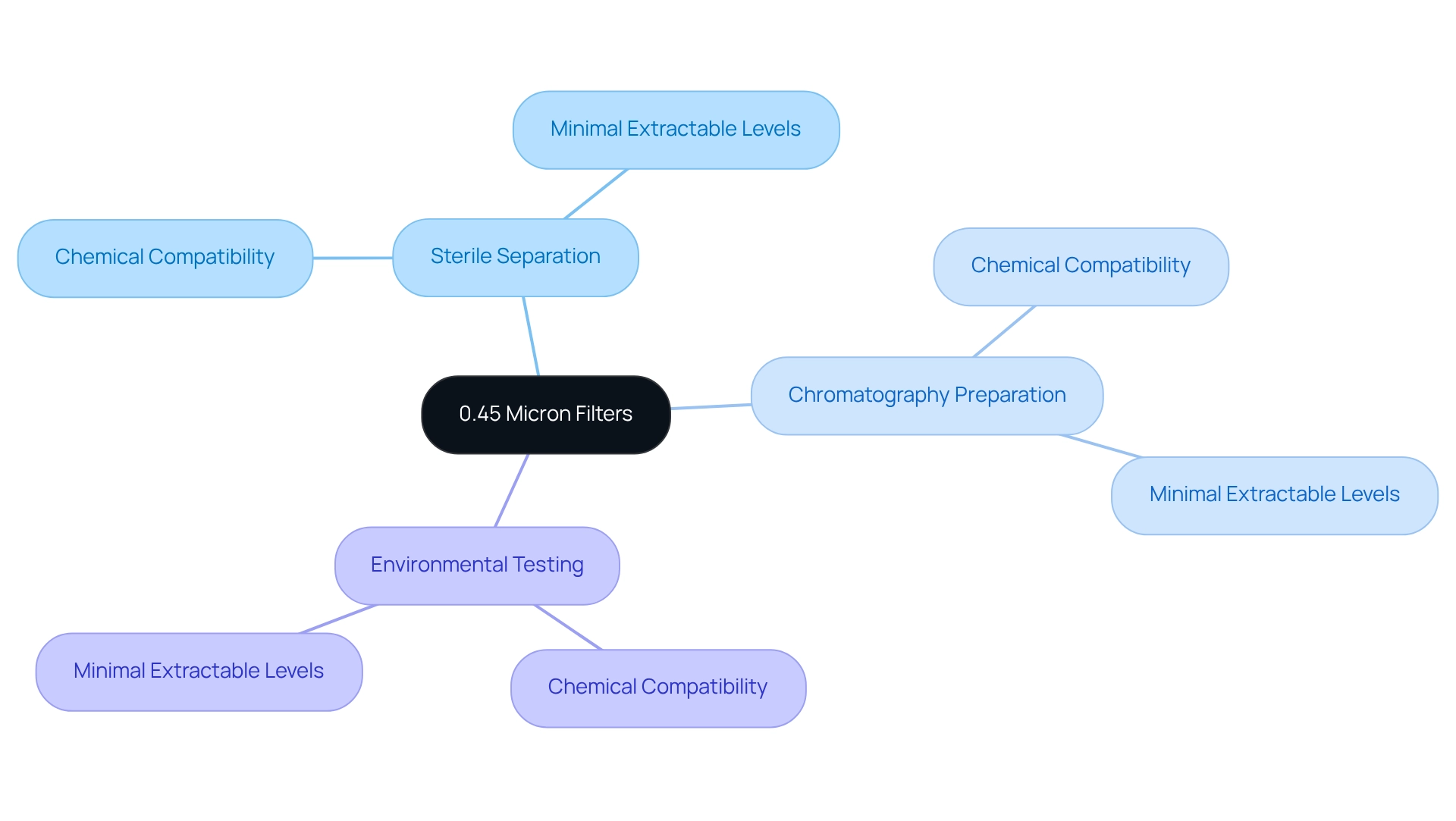
Significance of 0.45 Micron Filters in Pharmaceutical and Laboratory Settings
In pharmaceutical and laboratory environments, the use of a 0.45 micron filter is crucial for maintaining the sterility and purity of samples. These membranes are employed to sift through solutions intended for drug formulations, effectively preventing microbial contamination. By utilizing such tools, laboratories can meet stringent regulatory standards established by the FDA, which require products to be free from contaminants. This adherence is particularly vital in the production of injectable drugs and other sterile products, where even the slightest impurity can have significant consequences.
The importance of these membranes cannot be overstated. They not only ensure the integrity of the samples but also enhance the overall quality of pharmaceutical products. As laboratories strive to uphold the highest standards of safety and efficacy, the use of 0.45 micron filter membranes becomes indispensable. By implementing these filtration solutions, organizations demonstrate their commitment to excellence and compliance, ultimately fostering trust with consumers and regulatory bodies alike.
In conclusion, the application of 0.45 micron filter membranes is essential in the pharmaceutical industry. Their role in preventing contamination safeguards the quality of injectable drugs and sterile products, aligning with regulatory requirements. As the industry continues to evolve, the reliance on such high-quality scientific instruments will only grow, underscoring the necessity for laboratories to invest in reliable filtration technologies.
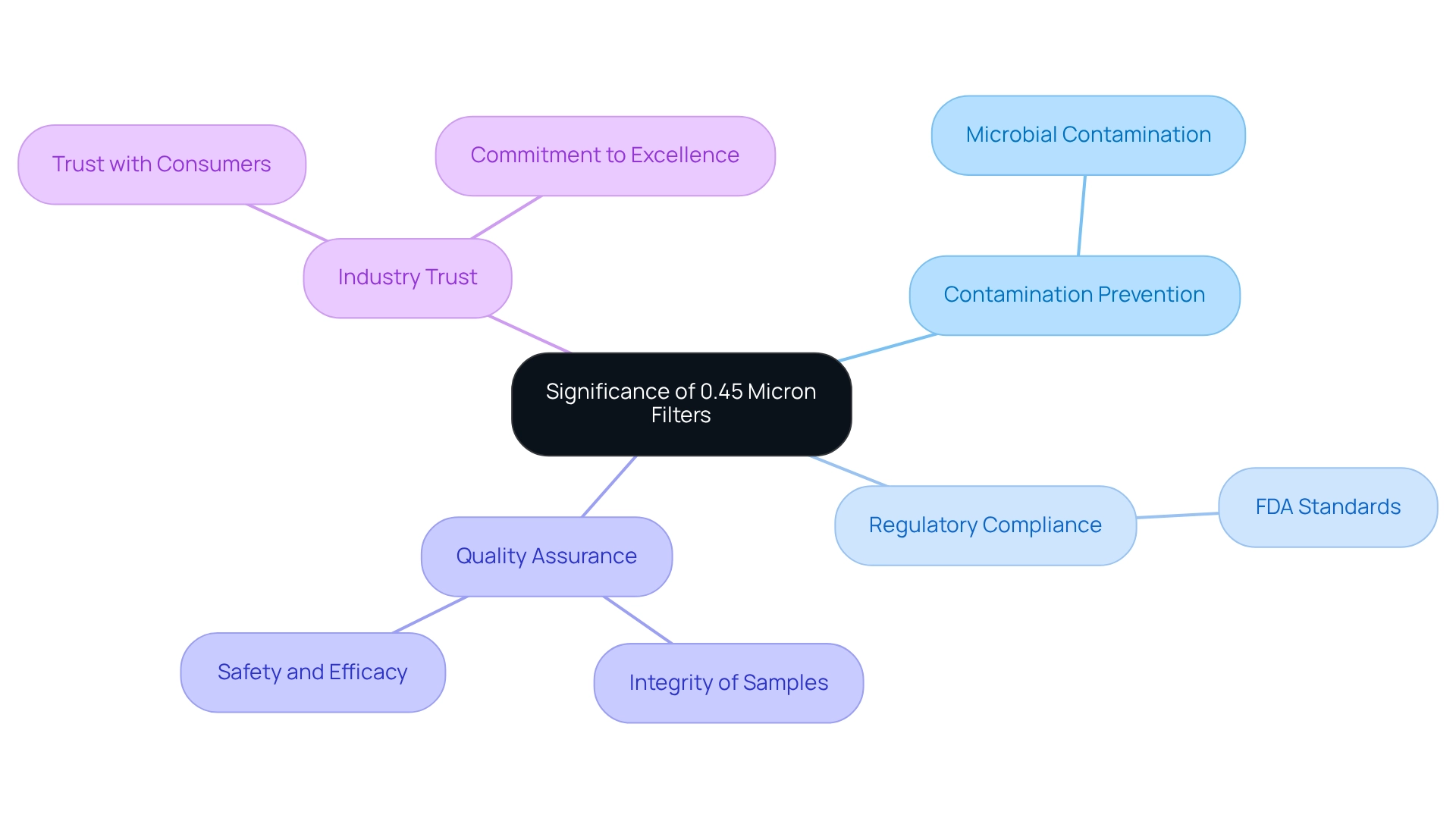
0.45 Micron Filters vs. Other Pore Sizes: Key Differences and Benefits
When contrasting 0.45-micrometer screens with other pore dimensions, such as 0.22-micrometer screens, it is essential to consider the intended application. While 0.22-micrometer screens are more suitable for sterilization purposes, the 0.45 micron filter provides a balanced solution between filtration efficiency and flow rate. These screens are less susceptible to clogging, making them ideal for rapidly filtering larger volumes of liquid. This characteristic proves particularly advantageous in scenarios where speed is critical, such as in high-throughput laboratories. Understanding these distinctions is vital for selecting the appropriate filtration method, including the use of a 0.45 micron filter, to meet specific laboratory needs.
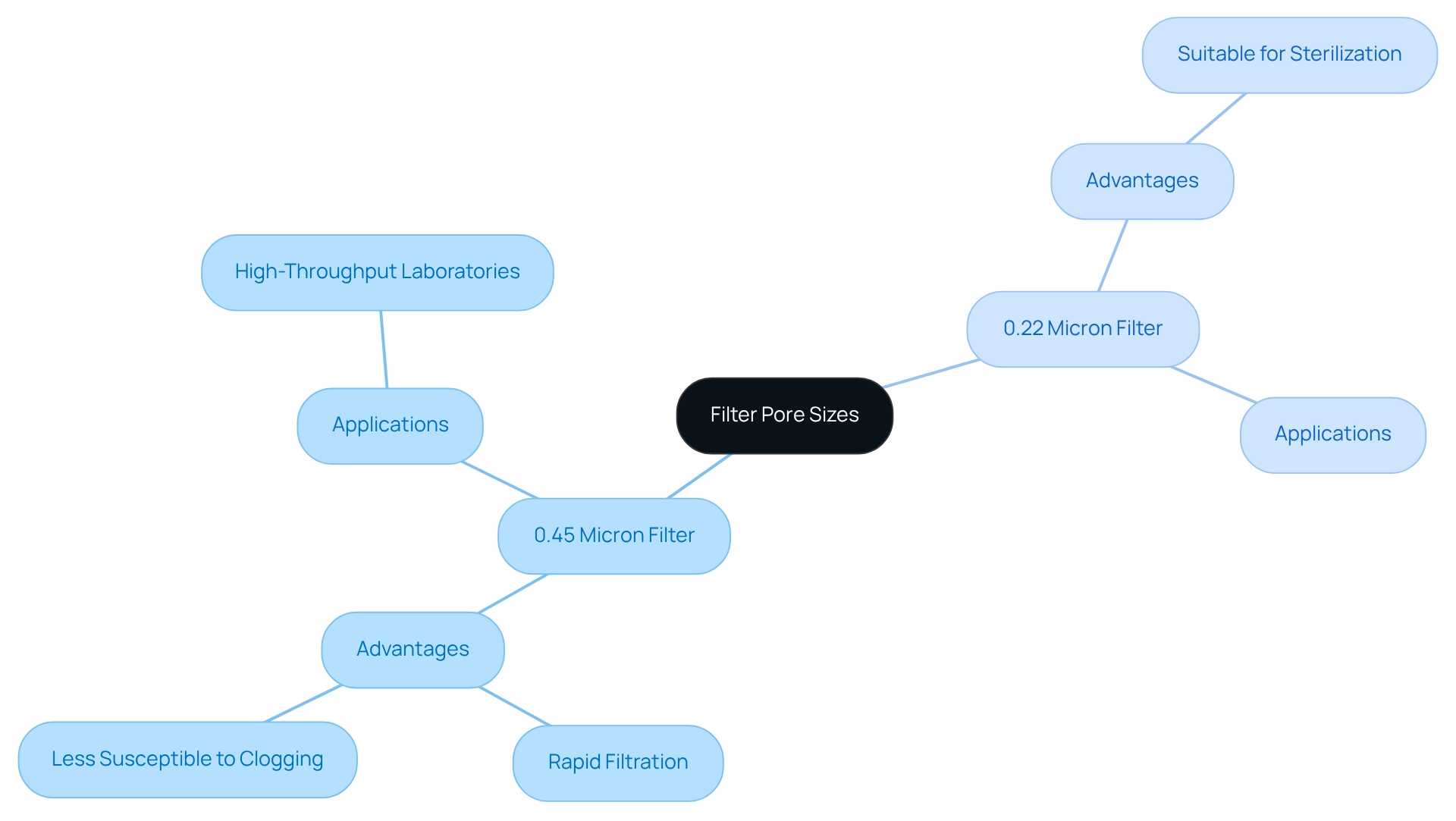
How 0.45 Micron Filters Work: Operational Principles Explained
The 0.45 micron filter operates on the principle of size exclusion, effectively preventing particles larger than the pore size from passing through. These devices are typically constructed from materials such as nylon, PTFE, or PES, which provide exceptional chemical compatibility and mechanical durability. Their design facilitates efficient flow rates while preserving the integrity of the specimen. Consequently, these membranes, which utilize a 0.45 micron filter, are well-suited for a range of laboratory applications, including HPLC specimen preparation. Understanding the significance of high-quality membranes is essential for any laboratory seeking to enhance its analytical capabilities.
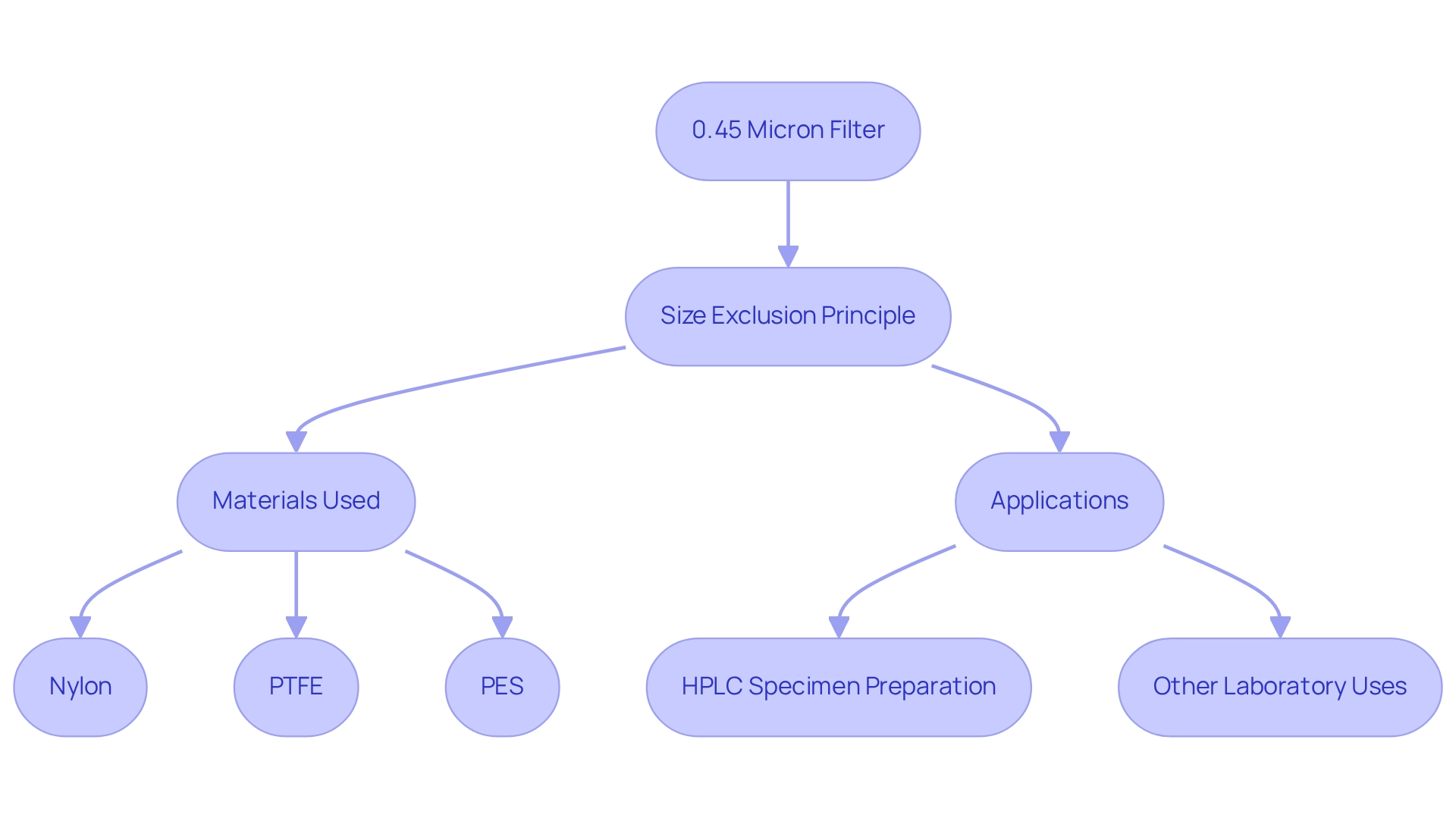
Applications of 0.45 Micron Filters: Where and How They Are Used
The importance of 0.45 micron filters in maintaining quality and safety across various sectors is underscored by their crucial role in numerous applications. In Pharmaceutical Manufacturing, these filters are essential for the sterile filtration of drug solutions, ensuring product safety and compliance with stringent health regulations. The Environmental Testing sector relies on a 0.45 micron filter to purify water specimens for microbial examination, thereby ensuring adherence to environmental regulations and safeguarding public health. Furthermore, in the Food and Beverage Industry, these filters are utilized for clarifying liquids, ensuring that products are free from contaminants and meet safety standards. Finally, in Biotechnology, the use of a 0.45 micron filter is integral to cell culture processes, effectively removing particulates and maintaining sterility, which is vital for successful experimentation and product development. Each of these applications highlights the necessity of high-quality filtration systems in ensuring safety and compliance across industries.
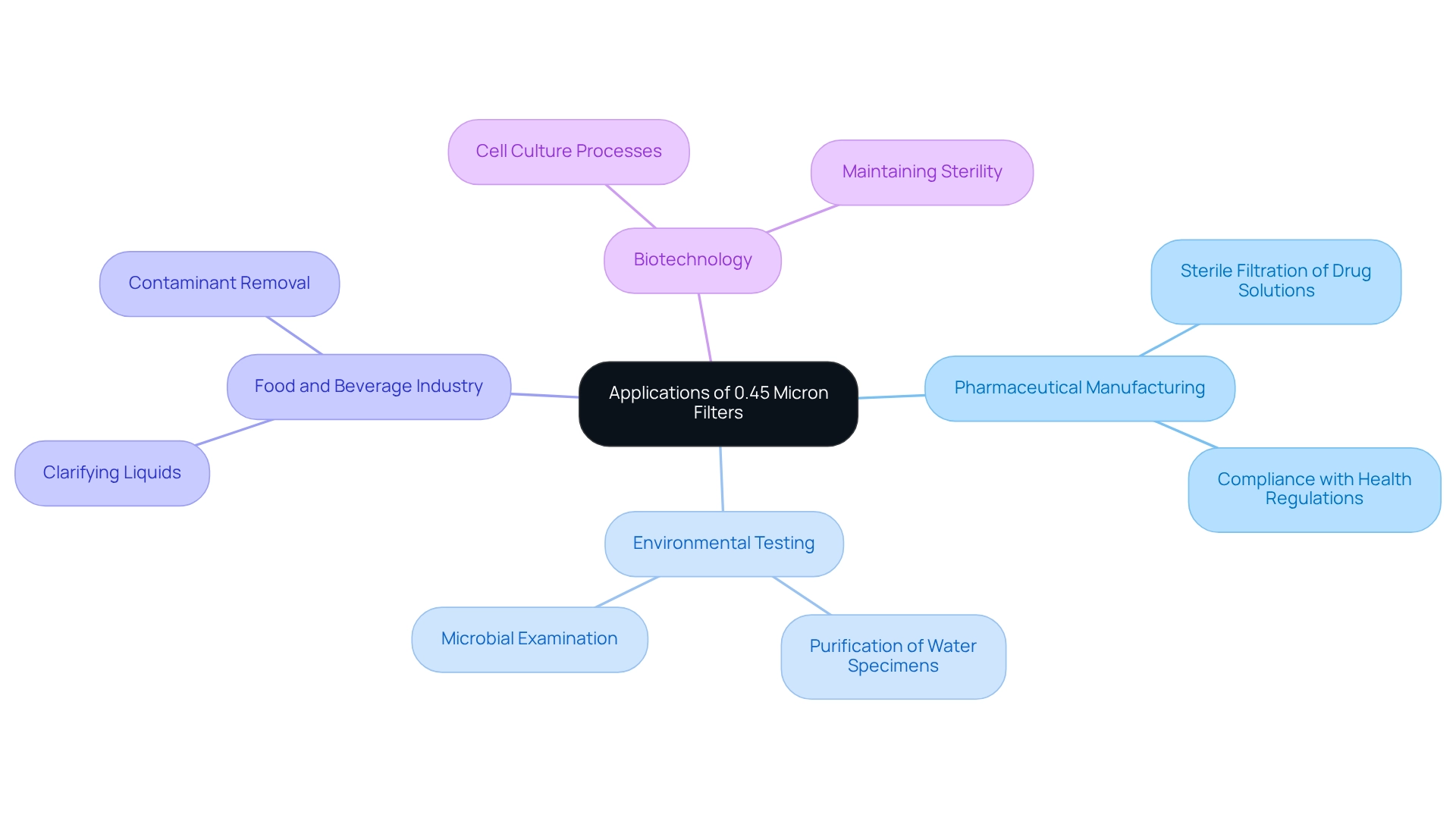
Choosing the Right 0.45 Micron Filter: Key Considerations
When selecting a 0.45 micron filter, it is crucial to consider several key factors that will impact your decision. First,
- Material Compatibility is paramount; ensure that the filter material aligns with the solvents or samples you intend to filter.
- Next, assess the Flow Rate; it is vital to choose a device that provides a sufficient flow rate to prevent bottlenecks in your processes.
- Additionally, the Volume of Sample must be taken into account; larger volumes may require filters designed for higher throughput to maintain efficiency.
- Finally, clarify the Application Type; understanding whether the filter will be used for sterile filtration, specimen preparation, or another purpose will significantly impact your choice of design and material.
By carefully evaluating these factors, you can ensure optimal performance and reliability in your laboratory applications.
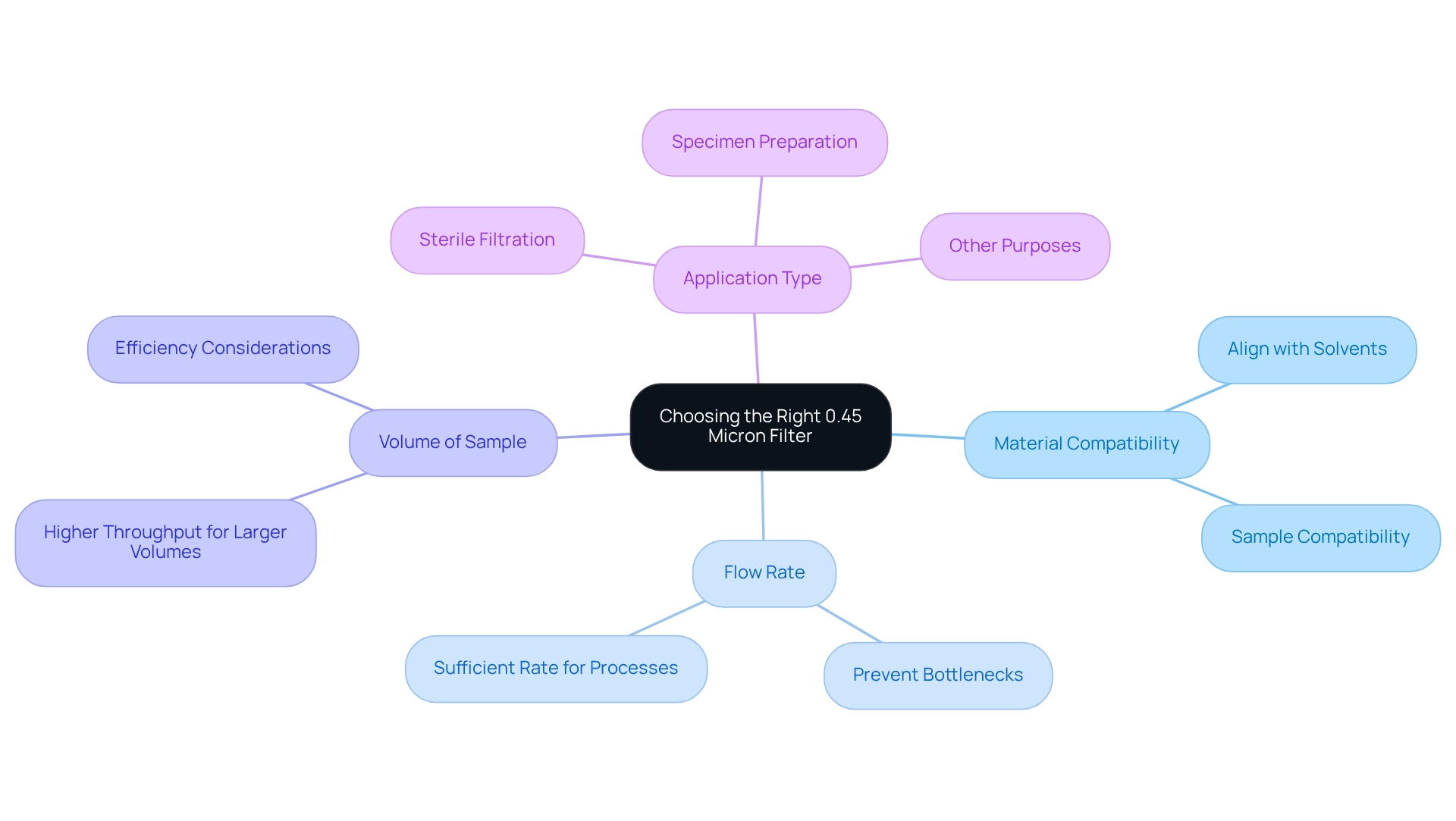
Benefits of 0.45 Micron Filters in Laboratory Research
The use of 0.45 micron filters in laboratory research offers several significant advantages. First and foremost, enhanced sample purity is achieved as these filters effectively remove contaminants, thereby ensuring that experimental results are both reliable and reproducible. This aspect is crucial for maintaining the integrity of scientific investigations.
Moreover, improved flow rates are another key benefit. These filters facilitate faster filtration processes, which is particularly essential in high-throughput environments where time efficiency is paramount. The ability to streamline operations can greatly enhance productivity in laboratory settings, and the versatility of using 0.45 micron filters cannot be overlooked. They are suitable for a wide range of applications, from microbial analysis to HPLC specimen preparation, making them an invaluable tool in various research contexts. This adaptability ensures that laboratories can meet diverse experimental needs effectively.
Finally, cost-effectiveness is a notable characteristic of these filters. Generally more affordable than devices with smaller pore sizes, 0.45 micron filters are a practical choice for many laboratories looking for quality without compromising their budget constraints. In summary, the benefits of using 0.45 micron filters in laboratory research—such as enhanced sample purity, improved flow rates, versatility, and cost-effectiveness—underscore their essential role in achieving reliable and efficient scientific outcomes.
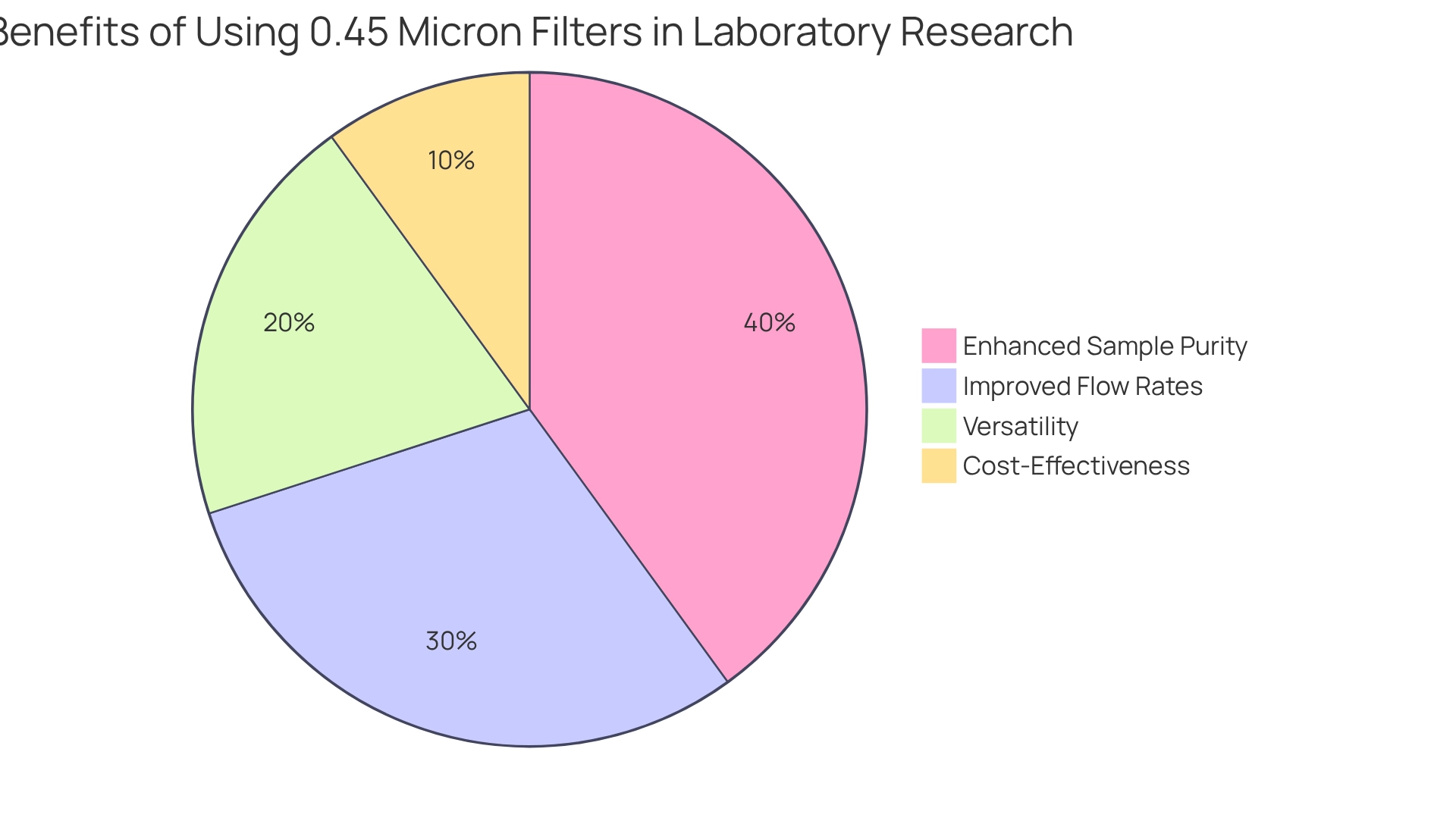
Challenges and Solutions in Using 0.45 Micron Filters
While users may face several challenges that warrant attention, 0.45 micron filters demonstrate high effectiveness.
- Clogging is a primary concern, particularly when samples contain elevated concentrations of particulates. To address this issue, pre-screening with a larger pore size membrane is advisable.
- Inconsistent flow rates can be indicative of a strainer nearing capacity; therefore, regular monitoring and timely replacement are crucial to maintaining optimal performance.
- Lastly, compatibility issues must be considered—ensuring that the materials used in the apparatus are suitable for the solvents employed is essential to avoid detrimental chemical reactions that could compromise system integrity.
By understanding and addressing these challenges, users can ensure the reliability and effectiveness of their filtration processes.
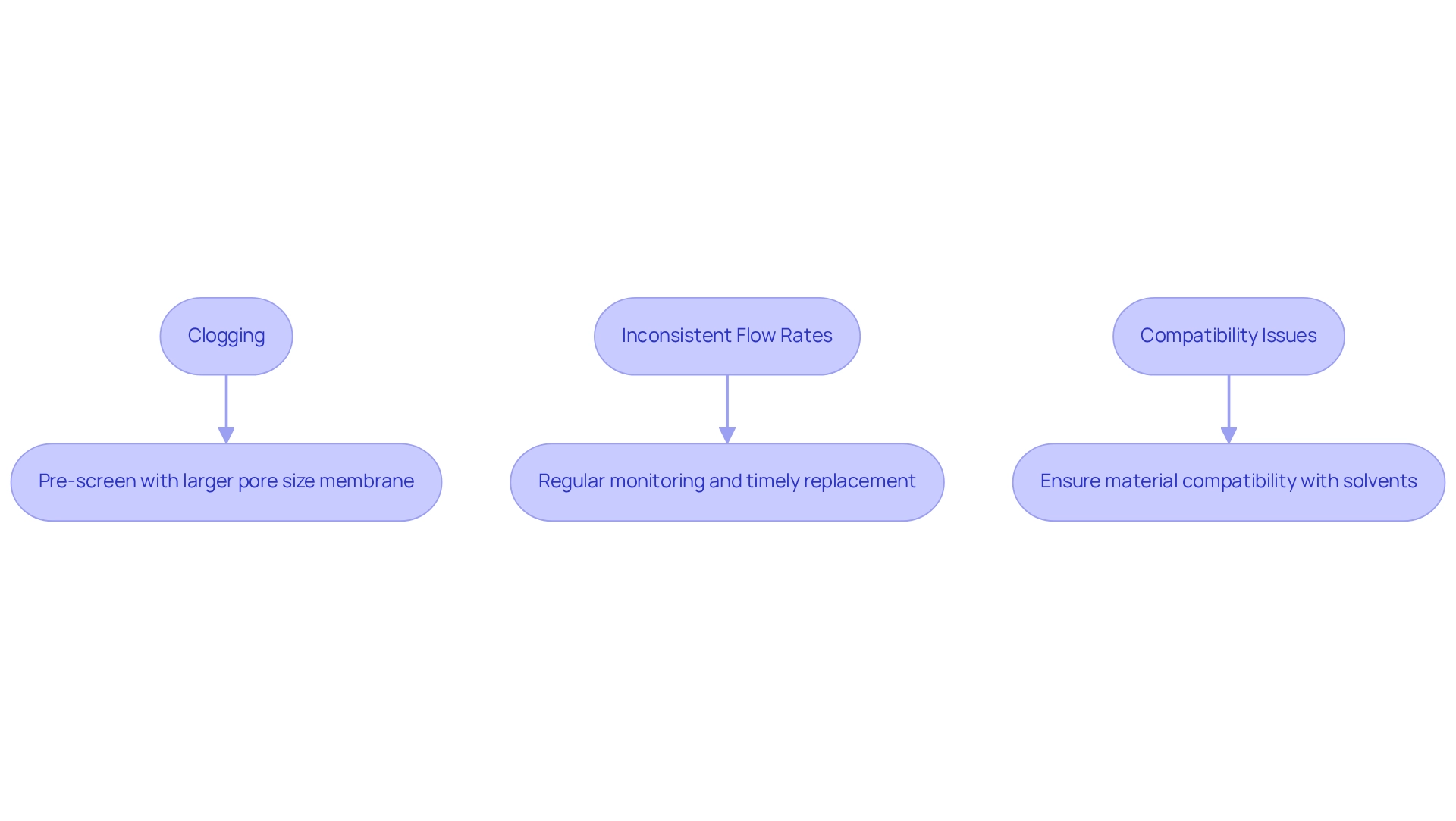
Essential Facts Recap: What You Need to Know About 0.45 Micron Filters
In summary, 0.45 micron filters serve as essential instruments within laboratory environments, particularly in pharmaceutical and analytical applications. These membranes are designed to effectively eliminate particles and microorganisms larger than the 0.45 micron filter, ensuring the integrity of samples and processes. Their adaptability allows for a wide range of uses, including sterile filtration and sample preparation, which are critical in maintaining high-quality standards in scientific work.
When selecting the appropriate filter, it is crucial to consider factors such as:
- Material compatibility
- Flow rates
- The specific needs of the application
These considerations will not only enhance performance but also ensure that the chosen membrane aligns with the intended laboratory objectives. Regular maintenance and monitoring are equally vital, as they guarantee optimal performance and longevity of the membranes, ultimately supporting the reliability of laboratory results. By understanding the significance of the 0.45 micron filter and the factors influencing its selection and maintenance, laboratory professionals can make informed decisions that uphold the highest standards of scientific excellence.
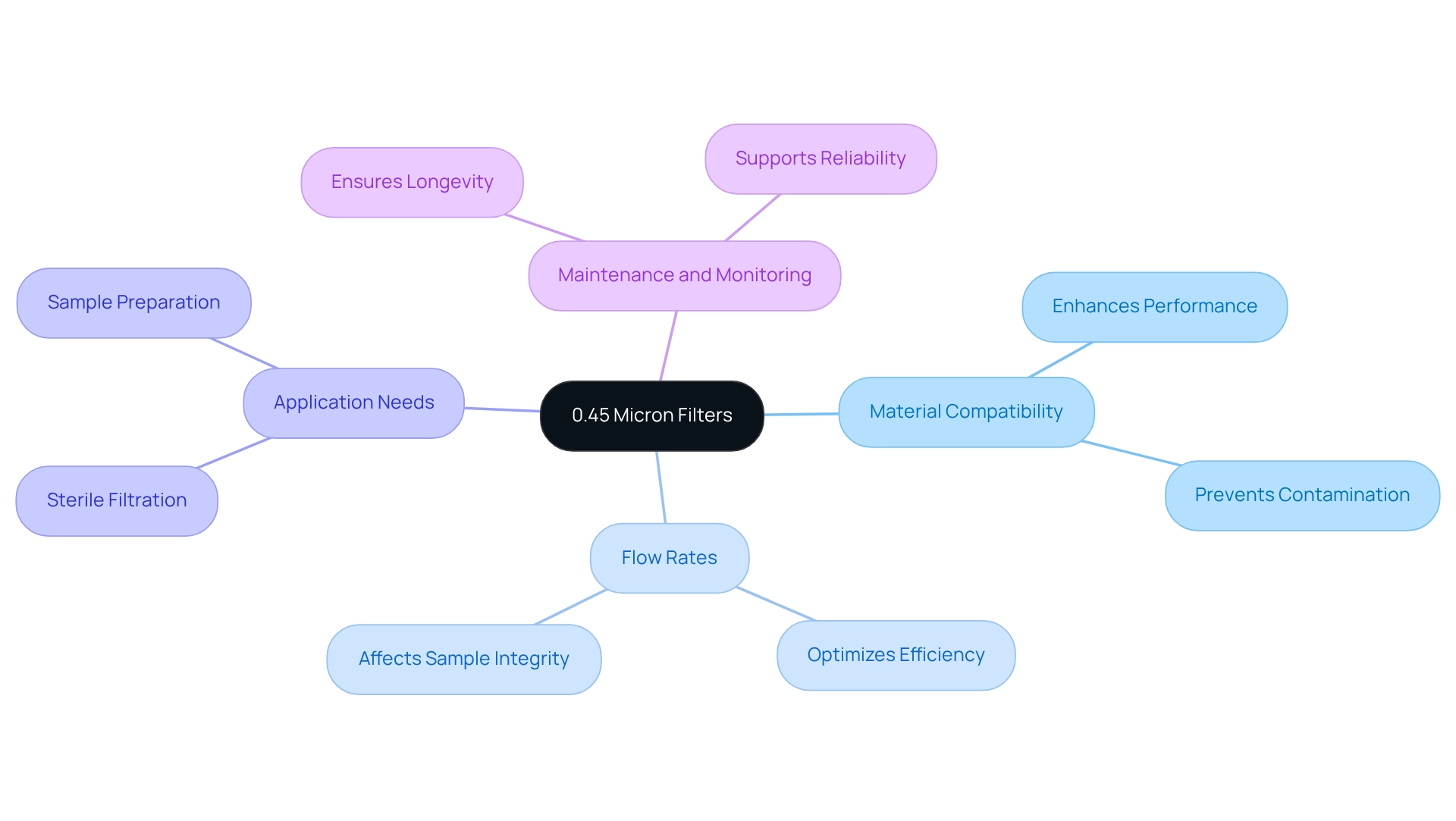
Conclusion
The significance of 0.45 micron filters in laboratory research and pharmaceutical development is paramount. These filters are essential for ensuring sample purity, effectively eliminating contaminants such as bacteria and yeast, thereby maintaining the integrity of scientific analyses. Their applications are diverse, encompassing sterile filtration, chromatography, and environmental testing, underscoring their versatility and importance across multiple fields.
Selecting the appropriate 0.45 micron filter necessitates careful consideration of factors such as material compatibility, flow rates, and the specific requirements of the application. By choosing the right filter, laboratories can enhance sample purity, boost filtration efficiency, and ensure adherence to regulatory standards. Additionally, regular maintenance and monitoring are crucial for optimizing the performance of these filters, thus safeguarding the quality of research outcomes.
In summary, 0.45 micron filters are indispensable instruments in the quest for accuracy and reliability in scientific research. Their capacity to balance filtration speed with effectiveness renders them a favored choice for laboratories committed to maintaining the highest quality standards. As the demand for precision in laboratory environments continues to escalate, the role of these filters will remain central to the success of pharmaceutical development and analytical processes.




